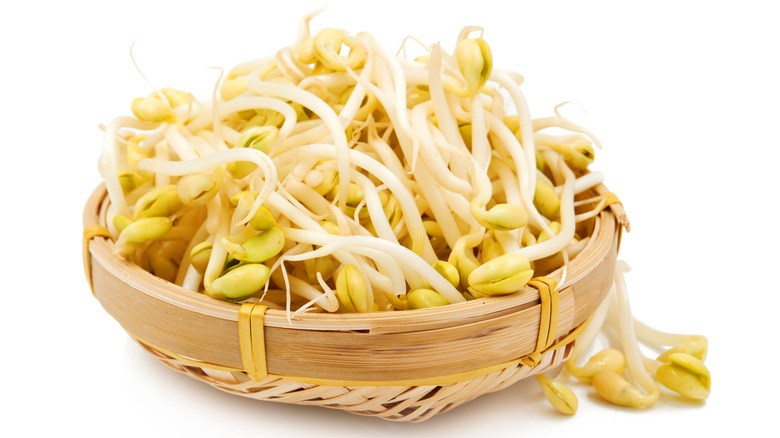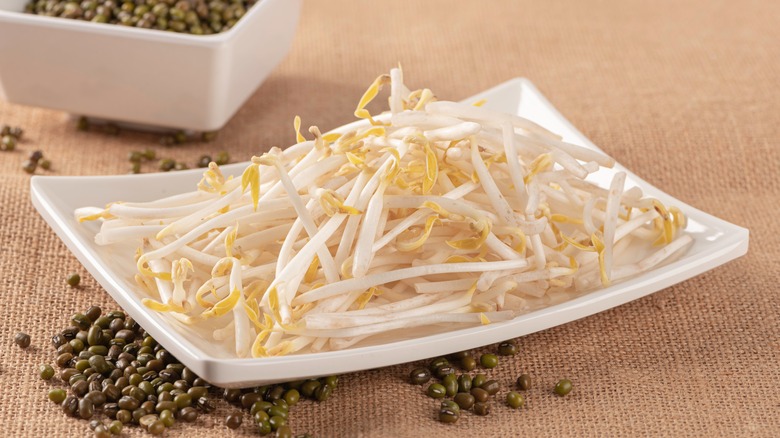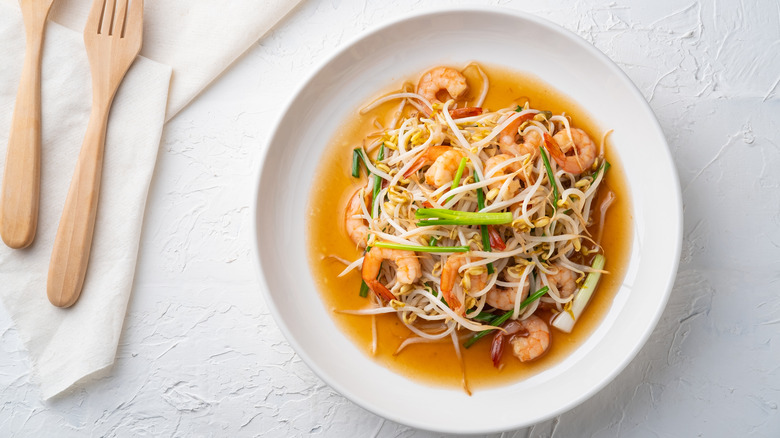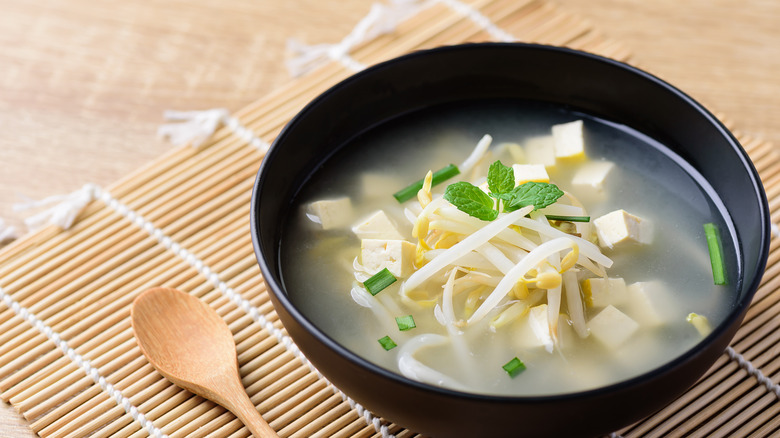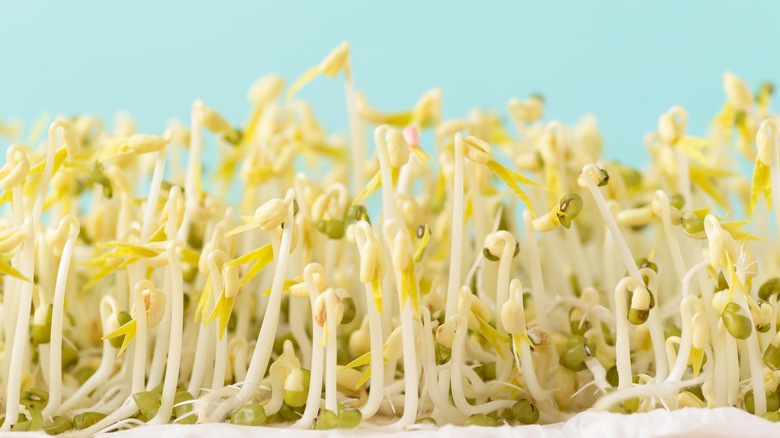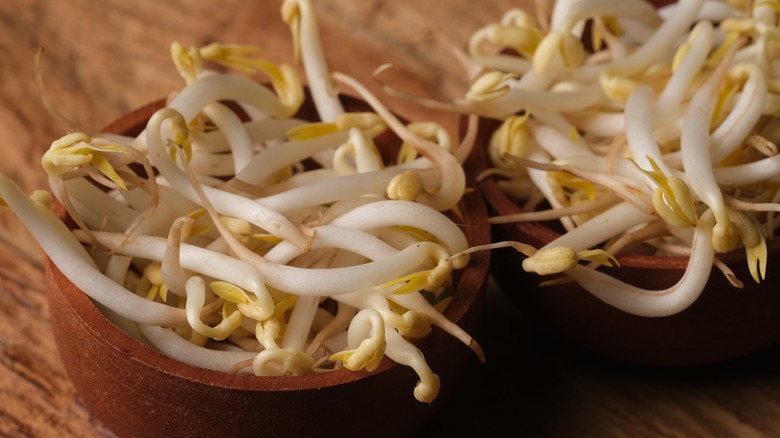Mung Bean Sprouts Date Back 5,000 Years
Sometimes a stroll through grocery store aisles can feel overwhelming — what ingredients to pick up for that seamless weeknight meal? Veggies are a good start, especially a sort that doesn't need much cooking time. So try adding mung bean sprouts to the shopping list. This versatile ingredient is the perfect extra veggie to toss into a salad, stir fry, or soup. Widely consumed across Asia, these small white stalks add a palatable crisp, all underpinned with just a bit of sweet and nutty flavors. Sold in a sizeable bunch, they're an affordable add-on in the grocery basket and can be incorporated into a range of dishes.
With such favorable qualities, it's no wonder these sprouts have been cultivated for thousands of years. Plus, they pack in qualities beneficial for health alongside a small calorie count — no need to worry about their impact on nutrition. Let's dive into what mung bean sprouts are all about.
What are mung bean sprouts?
Mung bean sprouts proliferate from whole mung beans. These legumes, which resemble green beans when whole or green-colored black-eyed peas when dehulled, are known as green gram in Indian cuisine. And while raw mung beans also have many culinary applications, it's the sprout that has the most ubiquity. It only takes these thin stalks two to five days to germinate, and the process can occur any time of year. The resulting shoot, which is firm, white, and crunchy, is a delicious additive to an array of dishes.
Such a process of cultivation has occurred in Asia for 5,000 years, with origins pointing towards modern-day India. From there, the sprout spread throughout Southeast Asia and China, where it's also been cultivated for millennia. Commercial production started in the U.S. in 1830, mainly around Texas and California. Now, the vegetable is found on many continents and is easy to both purchase and growth.
Flavor and culinary usage
Mung bean sprouts have a mild vegetal taste, with just a hint of sweet and nutty flavors. Texturally, the outside of the sprout is smooth, and the vegetable has an addicting crunch. Such a palatable mouthfeel makes them an excellent filler component. Mung bean sprouts don't overpower other ingredients and instead fuse with the sauces, spices, and chilies tossed into a dish. For their optimal flavor, it's important to cut off the brown root segment of the sprout.
The shoots do well with heat, although not over prolonged durations. They're typically added at the end of the cooking process. In stir fry, for instance, they're only stirred into the wok during the last minute of preparation. Alternatively, with soups, they're tossed into the broth to allow residual heat to soften the sprout. And if prepared into a salad, the sprouts are blanched for a minute before use.
While raw mung bean sprouts are edible, it's best to cook the vegetable to avoid illness. If sanitation isn't impeccable during germination, the process can breed dangerous bacteria infections like E.Coli, notes Love Vegan Living. As a result, wash the sprouts thoroughly, and apply a short duration of heat to decontaminate the product.
Dishes with mung bean sprouts
Mung bean sprouts are a recognizable ingredient in many stir-fries across Southeast Asia. They're essential in pad Thai, contributing to the appetizing texture. In Chinese and Taiwanese cuisine, they're often stir-fried with garlic, served either as a side dish or combined with chicken or beef as an entrée. The shoots can also be an excellent topping for soup, part of the herbal medley atop pho. In India, the sprouts are stewed alongside basmati rice, turmeric, and other spices in a dish known as kitchari.
Combing the vegetable with liquid is also common in Korea, where the shoots are boiled in dashi, garlic, and onion for a nourishing soup called Kongnamul Guk. The easy-to-put-together creation is served alongside steamed rice. Bean sprout salad, called sukjunamul-muchim, is a common banchan in Korea. For the preparation, the sprouts are boiled, then combined with sesame oil, fish sauce, salt, and other flavorings. With their pleasant taste and ease of use, it's no surprise the vegetable has taken off across Asia.
Nutrition of mung bean sprouts
Mung bean sprouts pack in nutrition for only a few calories. The young vegetable contains an abundance of peptides, which aid with blood pressure and cancer prevention. Additionally, the stalks offer a source of dietary fiber, which aids with digestion. And mung bean sprouts also contain antioxidants, specifically a kind that helps against worsening vision. Such benefits are provided with a cup of the sprout containing only 31 calories, according to WebMD.
When it comes to vitamin makeup, mung bean sprouts are especially high in vitamin K, which aids with bone density and controls calcium buildup in blood vessels. The shoots also offer a dose of vitamin C, which offers protection against free radicals, as well as immune-boosting iron, per SFGate. The vegetable is most nutritious when raw, but a bit of heat won't eliminate their benefits. Simply add them to your favorite dish for a healthy boost.
Where to buy and how to store the sprouts
Mung bean sprouts are becoming increasingly common and easy to find in grocery stores. If missing on your closest aisle, head to an Asian grocery or a vegetarian-focused store. It's not difficult to sprout your own, although that involves finding the parent mung beans, which are a little less common than the sprout. The sprouts are also sold in cans, which are readily available online, although such a processing method doesn't quite preserve their fresh tang.
When purchasing mung beans, check for freshness — the vegetable tends to spoil quickly. Look for thick, white-colored sprouts, avoiding any browning. It's best if they're not slimy, and the aroma should be neutral, without pleasant undertones. Once purchased, plan on using the bean sprouts within a few days. Do not wash until added to cooking, and store in a plastic bag with a paper towel. After a haul, use in abundance — no one will turn down their crunchy bite.
